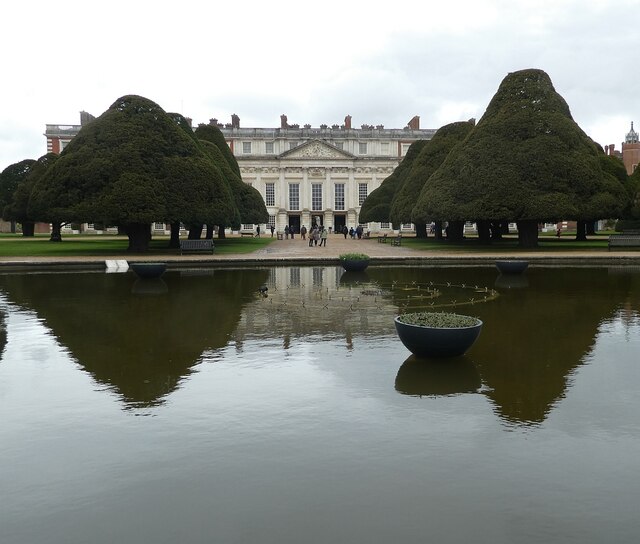TQ1568 : Hampton Court - Eastern fašade across circular pond
taken 2 years ago, near to East Molesey, Surrey, England

The first thing to say about Hampton Court Palace is that it is vast - more like a small town than a house.
It was begun in 1514 by Cardinal Thomas Wolsey in the reign of Henry VIII (reigned: 1509-1547) for whom he was Chief Minister at the time. But Wolsey fell out of favour with the monarch over the latter's desire to have his marriage to Catherine of Aragon annulled, which Wolsey resisted as the Pope's representative in England. In order to appease the King's ire, Wolsey gave him the palace (on which he had already spent the vast sum of 200,000 gold crowns, untold millions in today's money) in 1529. Wolsey died the following year, once more in the King's bad books.
Henry set about expanding the already lavish palace and turning into perhaps his favourite residence (of which he had many).
Towards the end of the following century William III (co-ruler from 1689 with his wife Mary II until her death in 1694, then as sole monarch until his death in 1702) expanded the palace greatly and altered many of the original Tudor features. This huge Baroque extension, though very different in style from the original building is strangely harmonious mainly due to the sympathetic use of similar building materials (predominantly pink bricks) also the scale and symmetry were generally adhered to. The last monarch to reside here was George II, a very distant relation of Mary II, but only three monarchs later (Anne, George I in between).
On visiting today, the palace is an intriguing warren, most particularly the Tudor 'streets' around the kitchens. It is almost three historic properties in one as there are the distinct areas of the Tudor (Henrician) palace in particular the kitchens and Great Hall; secondly the William III wing and thirdly the Georgian rooms.
Vast amounts have been written about this palace and I can only skim the surface here. For more information here are some useful links:
Historic Royal Palaces website: Link
EH Scheduled Ancient Monument: Link
Park & Garden (Grade I): Link
Grade I listed properties:
The Palace: Link
Lower Orangery: Link
Banqueting House: Link
Barracks: Link
Trophy Gates: Link
Tilt Yard Tower: Link
Real Tennis Court: Link
Fountain Garden (1): Link
Fountain Garden (2): Link
Fountain Garden (3): Link
Walls & Railings: Link
Privy Garden: Link
Lion Gates: Link
Flowerpot Gate: Link
Hampton Court Palace is a royal palace in the London Borough of Richmond upon Thames in south west London; it has not been lived in by the British royal family since the 18th century. The palace is located upstream of Central London on the River Thames. It was originally built for Cardinal Wolsey, a favourite of King Henry VIII, circa 1514; in 1529, as Wolsey fell from favour, the palace was passed to the King, who enlarged it.
Link
Hampton Court website: Link
Built in 1514 as a private residence for Cardinal Wolsey, the palace was presented to Henry VIII to secure the King's favour. Along with St. James's Palace, it is one of only two surviving palaces out of the many owned by King Henry VIII. In the following century, following the accession of William and Mary, King William III's massive rebuilding and expansion project was intended to rival the Palace of Versailles. During this work, half the Tudor palace was replaced and Henry VIII's state rooms and private apartments were both lost; the new wings around the Fountain Court contained new state apartments and private rooms, one set for the King and one for the Queen. Work ceased in 1694, after the death of Queen Mary; this left the palace in two distinct contrasting architectural styles, domestic Tudor and Baroque.
No monarch has ever resided at Hampton Court since the reign of King George II and during the reign of Queen Victoria, the palace was opened to the public. Today, the palace and its gardens are open to the public and a major tourist attraction; the structure and grounds are cared for by an independent charity, Historic Royal Palaces Link, which receives no funding from the Government or the Crown.
Hampton Court Palace is a grade I listed building (English Heritage Building ID: 205384 LinkBritish Listed Buildings).
LinkHampton Court Website
LinkWikipedia page
